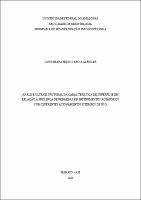| ???jsp.display-item.social.title??? |


|
Please use this identifier to cite or link to this item:
https://tede.ufam.edu.br/handle/tede/10172| ???metadata.dc.type???: | Dissertação |
| Title: | Análise ultraestrutural da característica de superfície em relação à presença de rebarbas em instrumentos rotatórios com diferentes acionamentos e tempos de uso |
| ???metadata.dc.creator???: | Alencar, Louisimara Jesus Garcia  |
| ???metadata.dc.contributor.advisor1???: | Marques, André Augusto Franco |
| First advisor-co: | Carvalho Junior, Jacy Ribeiro de |
| ???metadata.dc.contributor.referee1???: | João, Mariana Mena Barreto Pivoto |
| ???metadata.dc.contributor.referee2???: | Sponchiado Júnior, Emílio Carlos |
| ???metadata.dc.description.resumo???: | O objetivo deste estudo foi avaliar a presença de rebarbas nas superfícies de instrumentos endodônticos rotatórios por meio da Microscopia Eletrônica de Varredura (MEV) acionados manualmente e por motor elétrico em diferentes tempos de uso. Foram utilizados 40 instrumentos X2 (25/06) do sistema X-Gray® sendo inicialmente avaliados no Microscópio Eletrônico de Varredura (MEV) antes do primeiro uso. Foram selecionadas 40 raízes mesiais de molares inferiores com grau de curvatura entre 20° e 40° e raio de curvatura ≤10 mm distribuídos em dois grupos, Grupo 1, instrumentação com limas SX para o preparo cervical e médio e X2 para a modelagem do terço apical por meio do motor elétrico e no Grupo 2, estes instrumentos foram acoplados ao adaptador manual Ed File® para realizar a instrumentação e ambos os grupos foi utilizada a cinemática rotatória e cada instrumento foi utilizado em duas raízes. Para a padronização da posição da instrumentação foi confeccionado um bloco de silicone sendo fixado em uma morsa de bancada. O comprimento de trabalho dos canais mesiais foi definido a 0,5 mm aquém ao ápice. Após cada uso, novas eletromicrografias na ponta do instrumento a, 2 mm e a 4 mm com aumento de 180x foram realizadas para avaliação da presença de rebarbas, onde estes defeitos foram mensurados por meio do programa Fiji ImageJ. O hipoclorito de sódio a 2,5% foi a solução irrigante empregada, sendo utilizado 1 ml a cada inserção do instrumento. Os dados foram submetidos a análise estatística apontando diferença estatística significante (P<0,05) na região do 4°mm do grupo 1 quando comparado aos demais locais, ou seja, as rebarbas presente/ausentes nesta região foram muito maiores que as diferentes áreas avaliadas. Pode-se concluir que o 4° mm foi a área que mais apresentou defeitos do tipo rebarbas, principalmente após o primeiro e segundo uso e o adaptador manual é uma boa opção para o acionamento de instrumentos rotatórios. |
| Abstract: | The objective of this study was to evaluate the presence of burrs on the surfaces of rotary endodontic instruments using Scanning Electron Microscopy (SEM) operated manually and by an electric motor at different times of use. 40 X2 instruments (25/06) from the X-Gray® system were used and were initially evaluated using the Scanning Electron Microscope (SEM) before first use. 40 mesial roots of lower molars were selected with a degree of curvature between 20° and 40° and a radius of curvature ≤10 mm distributed into two groups, Group 1, instrumentation with SX files for cervical and middle preparation and X2 for shaping the third. apical by means of the electric motor and in Group 2, these instruments were coupled to the Ed File® manual adapter to perform the instrumentation and in both groups rotational kinematics was used and each instrument was used on two roots. To standardize the position of the instrumentation, a silicone block was made and fixed in a bench vise. The working length of the mesial canals was defined at 0.5 mm short of the apex. After each use, new electron micrographs at the tip of the instrument at 2 mm and 4 mm with 180x magnification were taken to evaluate the presence of burrs, where these defects were measured using the Fiji ImageJ program. 2.5% sodium hypochlorite was the irrigating solution used, with 1 ml being used for each insertion of the instrument. The data were subjected to statistical analysis, indicating a significant statistical difference (P<0.05) in the 4th mm region of group 1 when compared to the other locations, that is, the burrs present/absent in this region were much larger than the different areas evaluated. It can be concluded that the 4th mm was the area that showed the most burr-type defects, especially after the first and second use and the manual adapter is a good option for activating rotary instruments. |
| Keywords: | . . . |
| ???metadata.dc.subject.cnpq???: | CIENCIAS DA SAUDE |
| ???metadata.dc.subject.user???: | Endodontia Instrumentos odontológicos Tratamento do canal radicular Microscopia Eletrônica de Varredura |
| Language: | por |
| ???metadata.dc.publisher.country???: | Brasil |
| Publisher: | Universidade Federal do Amazonas |
| ???metadata.dc.publisher.initials???: | UFAM |
| ???metadata.dc.publisher.department???: | Faculdade de Odontologia |
| ???metadata.dc.publisher.program???: | Programa de Pós-graduação em Odontologia |
| Citation: | ALENCAR, Louisimara Jesus Garcia. Análise ultraestrutural da característica de superfície em relação à presença de rebarbas em instrumentos rotatórios com diferentes acionamentos e tempos de uso. 2024. 55 f. Dissertação (Mestrado em Odontologia) - Universidade Federal do Amazonas, Manaus, 2024. |
| ???metadata.dc.rights???: | Acesso Aberto |
| ???metadata.dc.rights.uri???: | https://creativecommons.org/licenses/by-nc-nd/4.0/ |
| URI: | https://tede.ufam.edu.br/handle/tede/10172 |
| Issue Date: | 2-Apr-2024 |
| Appears in Collections: | Mestrado em Odontologia |
Files in This Item:
| File | Description | Size | Format | |
|---|---|---|---|---|
| DISS_LouisimaraAlencar_PPGO.pdf | 2.49 MB | Adobe PDF |  Download/Open Preview |
Items in DSpace are protected by copyright, with all rights reserved, unless otherwise indicated.




